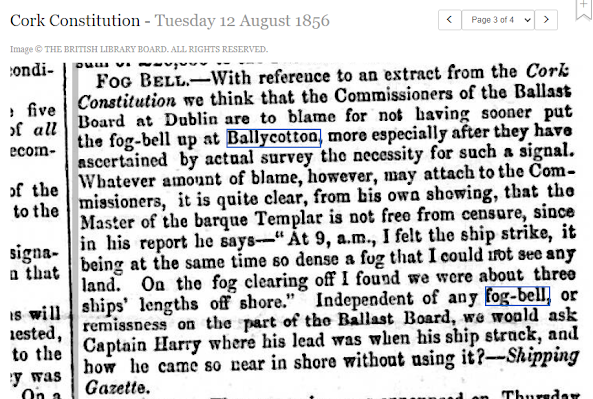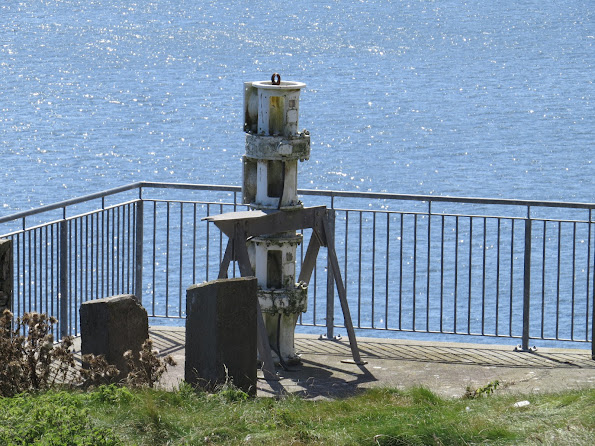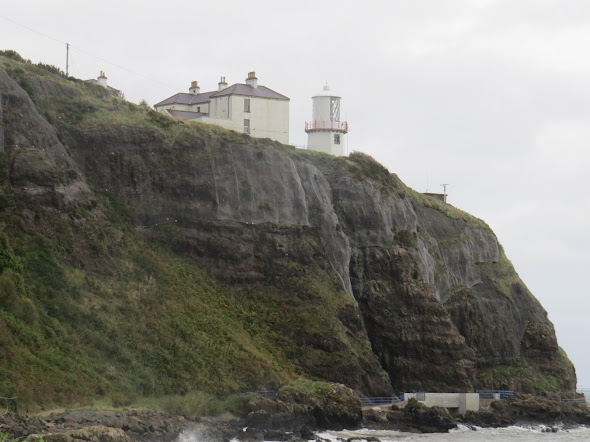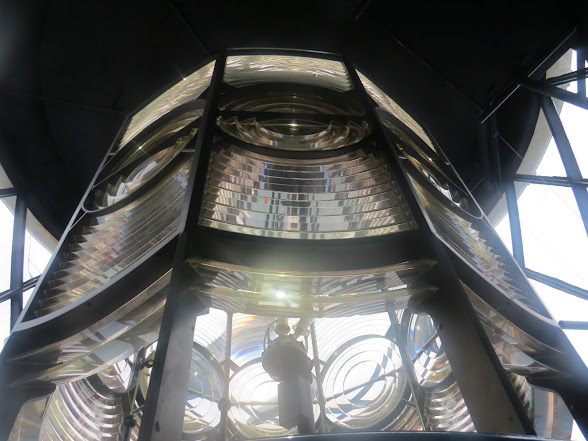
My thanks yet again to the multi-faceted John McCarron, sculptor, painter and local historian, for digging up a new photograph of Buncrana lighthouse, first established at the end of the pier in the southern end of Lough Swilly on 15th January 1876. When I first found out that the Buncrana light was actually the 1849 Newcastle co. Down light, rescued from the sea and recycled, I got in touch with Buncrana, who put me on to John, who has since done sterling, selfless work helping me with the histories of Buncrana, Dunree Head, Inishtrahull and all things Inishowen maritime.
The photograph above is, as stated, from the Lawrence Collection in the National Library and dates to around 1890. It seems that that crane photobombing the photo was very much a permanent fixture on the pierside, probably used for dredging and/or loading/unloading.
It very much complements another photograph from the same collection, taken from the Lough ; -

I don't know what the technical term is, but the cast-iron lighthouse has a hood - or is it a balaclava? - controlling the direction of the beam. Painted white, it bears a resemblance to both the ill-fated Bray lighthouse and also, and especially, the Sherkin Island lighthouse, both constructed towards the end of the 1800s. The latter two lights, though, have a balcony, which Buncrana lacked at the time.
Bray lighthouse

Sherkin Island lighthouse
James Tocker who was the foreman of works for the Ballast Board and Irish Lights for thirty years, was responsible for overseeing the building of many of Ireland's lighthouses including the first Fastnet and the ill-fated Calf Rock, both of which, I realise now, were also cast-iron and had a relatively short shelf life. But the demise of the Newcastle light was down to grave deficiencies in the construction of the pier and when erected in Buncrana, it lasted another 133 years.
One of the early keepers was David Moore Kennedy (Keeper 85 in the pantheon of Irish Lights) who appears to have begun his career in the company at Buncrana as an SAK on 1st March 1880. Strangely, he remained in the position for 9 years 6 months before being promoted to Assistant Keeper at Rotten Island, off Killybegs. It is probable he was a local man who did the job (probably as a second job) to boost his income before deciding that the pay was better as an AK. Most SAKs got promoted after a year or two.
It was probably he who agitated for a bit of an oul' shed to shelter in while on lightkeeping duties. Evidently, it didn't last very long - there's no sign of it in any of the old photographs.
The keeper in both 1901 and in 1911 was Jeremiah Logan, aged 62 and 72 respectively, quite unusual for his age rising exactly ten years in the decade between censuses. At the time, it was a fixed, white, oil light with a red sector but on 4th November 1916, it was converted to acetylene, a move which generally meant automation for the smaller harbour lights around the country. Jeremiah's death cert in 1919 calls him a 'retired lightkeeper.' The 1917 US Hydrographic List of Lights describes the character of the light as occulting, with white and red sectors. The light underwent a further change in 1951 when it was converted to electric. By this time, there were two red sectors to the light, one warning of the dangers of the Inch Spit; the second shining brightly over White Strand Rock.
At some stage in its existence, probably during the first light character change, the lighthouse got itself a little balcony and a white hat. In later years, the tower was painted black.
Photographs from the National Inventory of Architectural Heritage
For some reason, they decided to replace this light in 2009. It is difficult to call your children ugly but its replacement could have been a little bit more, erm, aesthetically pleasing. The old Buncrana - and Newcastle - light was then 160 years old and, knowing our attitude to conserving our maritime heritage, could easily have ended up being sold for scrap. Thankfully, Peter Gurrie and the lads and lasses at the Buncrana and West Inishowen Historical Society got their hands on it and, with the help of the good people at Crana Engineering, refurbished it and relocated it to the very popular Grianan Park overlooking the Lough, where it roams free, chats to the locals about the days when the boats were ten deep on the pier and is occasionally put out to stud.



























































.JPG)
